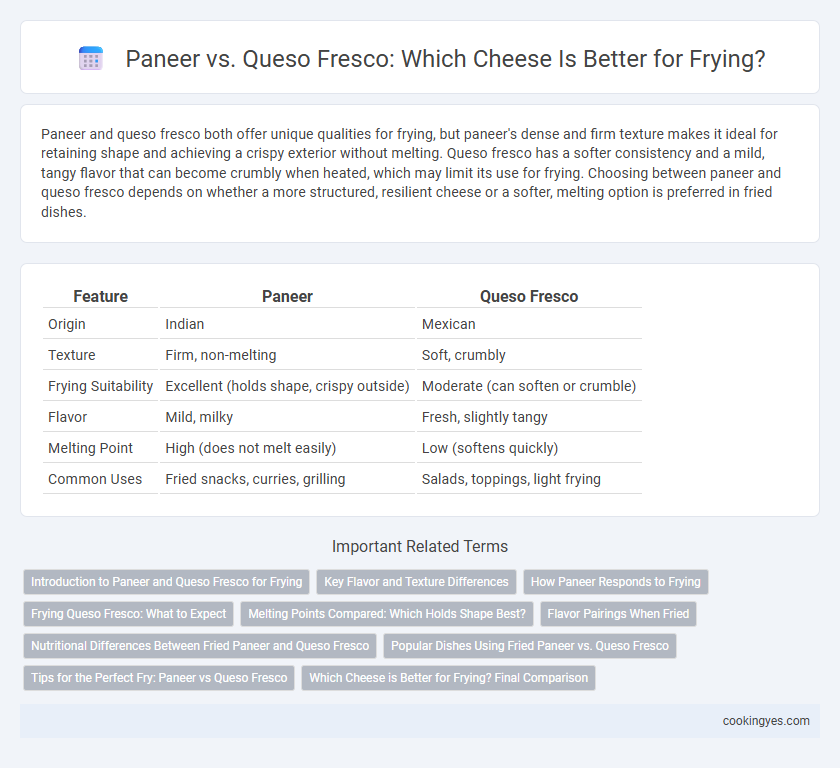Paneer and queso fresco both offer unique qualities for frying, but paneer's dense and firm texture makes it ideal for retaining shape and achieving a crispy exterior without melting. Queso fresco has a softer consistency and a mild, tangy flavor that can become crumbly when heated, which may limit its use for frying. Choosing between paneer and queso fresco depends on whether a more structured, resilient cheese or a softer, melting option is preferred in fried dishes.
Table of Comparison
| Feature | Paneer | Queso Fresco |
|---|---|---|
| Origin | Indian | Mexican |
| Texture | Firm, non-melting | Soft, crumbly |
| Frying Suitability | Excellent (holds shape, crispy outside) | Moderate (can soften or crumble) |
| Flavor | Mild, milky | Fresh, slightly tangy |
| Melting Point | High (does not melt easily) | Low (softens quickly) |
| Common Uses | Fried snacks, curries, grilling | Salads, toppings, light frying |
Introduction to Paneer and Queso Fresco for Frying
Paneer, a fresh Indian cheese made from curdled milk and lemon juice or vinegar, holds its shape well during frying due to its firm texture and high melting point. Queso fresco, a mild Mexican cheese crafted from cow or goat milk, is softer and crumbles easily, which can influence its performance in frying by providing a creamier, less structured result. Paneer's resilience to heat makes it ideal for crispy, golden-brown cubes, while queso fresco offers a tender, slightly melty alternative suited for lighter frying applications.
Key Flavor and Texture Differences
Paneer offers a mild, milky flavor with a dense, crumbly texture that holds its shape well during frying, resulting in a firm exterior and soft interior. Queso fresco presents a slightly tangy, salty taste with a softer, more crumbly texture that may soften further when fried, providing a creamy bite. These flavor and texture differences influence their frying performance and suitability in various dishes, with paneer favored for its sturdiness and queso fresco for its rich, tangy profile.
How Paneer Responds to Frying
Paneer maintains its firm texture and does not melt when fried, making it ideal for crispy dishes and retaining shape during cooking. Its high milk protein content allows it to brown evenly without becoming greasy or losing structural integrity. Unlike queso fresco, which tends to crumble or soften, paneer provides a consistent, chewy bite perfect for frying applications.
Frying Queso Fresco: What to Expect
Frying queso fresco results in a crispy, golden exterior while retaining a soft, creamy interior, making it ideal for dishes that require a mild, slightly tangy cheese that doesn't melt completely. Unlike paneer, which holds its shape firmly when fried due to its denser texture, queso fresco softens more quickly but still maintains enough structure to avoid disintegrating. Expect a delicate balance of textures and a subtle, fresh flavor that enhances fried dishes without overpowering them.
Melting Points Compared: Which Holds Shape Best?
Paneer and queso fresco have distinct melting points influencing their performance in frying; paneer melts at around 120degC, maintaining its firm texture and shape without turning gooey, making it ideal for pan-frying or deep-frying. Queso fresco melts at a lower temperature, approximately 90degC, causing it to soften and lose shape more quickly under heat. Thus, paneer holds its shape best during frying, while queso fresco is better suited for dishes requiring a softer, crumblier texture.
Flavor Pairings When Fried
Paneer's mild, creamy texture absorbs spices well, making it ideal for frying with Indian seasonings like cumin, turmeric, and garam masala. Queso fresco retains its crumbly texture and slightly tangy flavor when fried, pairing excellently with Mexican ingredients such as cilantro, lime, and chili powder. Both cheeses offer versatile flavor profiles that complement diverse, aromatic seasonings in fried dishes.
Nutritional Differences Between Fried Paneer and Queso Fresco
Fried paneer contains higher protein and fat content compared to queso fresco, making it a more calorie-dense option suitable for those needing sustained energy. Queso fresco, lower in fat and calories, provides a lighter alternative with a milder flavor and reduced sodium levels, which can support heart health. Both cheeses offer essential calcium, but paneer typically delivers a greater amount per serving, enhancing bone strength and nutritional value in fried dishes.
Popular Dishes Using Fried Paneer vs. Queso Fresco
Fried paneer is a versatile ingredient in popular Indian dishes such as paneer tikka and paneer pakora, known for its firm texture that holds up well during frying. Queso fresco, a softer Mexican cheese, is commonly used fried in dishes like chiles rellenos and empanadas, where it melts slightly but maintains a creamy texture. The distinct textures and melting points of paneer and queso fresco influence their culinary applications in fried recipes across Indian and Mexican cuisines.
Tips for the Perfect Fry: Paneer vs Queso Fresco
Paneer and queso fresco differ in moisture content and melting properties, affecting their frying performance. For perfect frying, use paneer as it holds shape well due to its dense texture, while queso fresco requires gentle handling to prevent crumbling. Fry paneer in medium heat with minimal oil to achieve a golden crust, whereas queso fresco benefits from a lightly oiled nonstick pan and brief cooking time to maintain its delicate texture.
Which Cheese is Better for Frying? Final Comparison
Paneer and queso fresco differ significantly in texture and melting properties, making paneer a better choice for frying due to its firm, non-melting consistency that holds shape under high heat. Paneer's ability to absorb spices and develop a crispy crust contrasts with queso fresco's crumbly texture, which tends to break apart when fried. For dishes requiring distinct fried cheese pieces, paneer provides superior structural integrity and flavor retention compared to queso fresco.
Paneer vs queso fresco for frying Infographic

 cookingyes.com
cookingyes.com